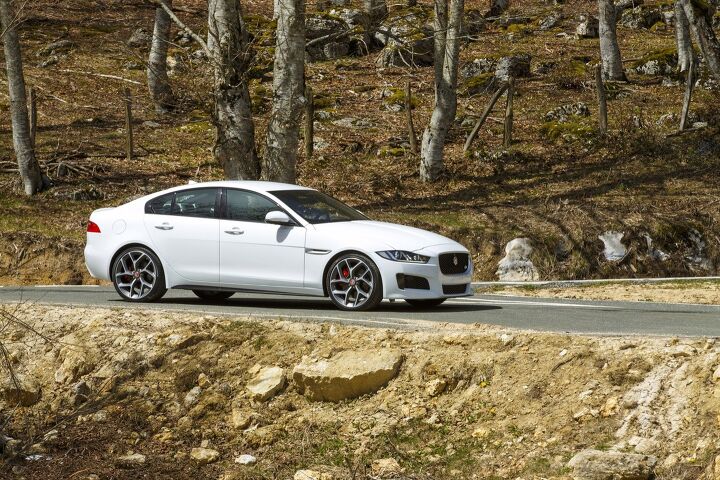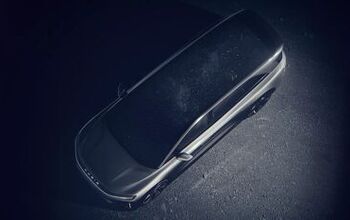Jaguar Doesn't Want To Get Too Popular
Jaguar’s U.S. volume more than doubled in 2016, rising to a 12-year high thanks to the launch of an all-new entry-level sedan and the brand’s first-ever SUV.
The XE and F-Pace, which now account for nearly three-quarters of Jaguar’s U.S. volume, have taken the brand to a high-volume place (relatively speaking) Jaguar hasn’t visited since the X-Type roamed dealer forecourts.
One year ago, those models didn’t exist, and Jaguar was selling fewer than 50 cars per day in America.
Now Jaguar’s on fire. Year-over-year growth is explosive, with Jaguar’s U.S. volume more than doubling in each of the last ten months and more than tripling in each of 2016’s final three months.
That level of growth can’t be sustained. Jaguar Land Rover North America’s CEO Joachim Eberhardt told Wards Auto, “We have to continue to grow, but we are not looking to grow at the pace we have been.”
All that growth “still does not make us a giant luxury brand,” Eberhardt says. “It makes us a bigger luxury brand that now has scale but is still special and exclusive.”
There’s the key word. Exclusive. “I think that is part of our appeal and something to focus on maintaining,” claims Eberhardt.
What a revolutionary approach for a premium auto brand.
Of course, Jaguar isn’t the only portion of Tata’s Jaguar Land Rover machine. Jaguar, in fact, is the smaller cog. And growth at Land Rover has been significant, as well. Though Land Rover sales are actually down slightly through the first two months of 2017, calendar year 2016 was the brand’s best U.S. sales year ever, with volume across the brand doubling between 2011 and 2016.
Powered by a massive lineup expansion that isn’t yet complete — the Range Rover Velar is up next — Land Rover is entirely present in the heart of the luxury market’s growth sector: SUVs. Land Rover doesn’t sell a single passenger car.
Jaguar, on the other hand, required an SUV to shed its cars-only status. And by launching the F-Pace, Jaguar ended up producing 30 percent of JLR’s U.S. volume in 2016, nearly double its 17 percent share one year earlier. Through early 2017, 35 percent of JLR’s U.S. sales are Jaguar-derived.
But we’ve yet to see whether Jaguar can further its charge into a U.S. luxury market dominated by Mercedes-Benz, Lexus, and BMW, brands which are capable of selling more vehicles in a single month than Jaguar did all of last year. Comparisons that will show whether the full Jaguar lineup — F-Pace, XE, XF, XJ, F-Type — can grow relative to the volume achieved by the full five-pronged Jaguar lineup in the year-ago period won’t occur for another two months.
Based on Eberhardt’s language, however, it appears as though Jaguar’s expectations are not lofty. Although Jaguar sold more than 50,000 vehicles in America as recently as 2003, 40,000-45,000 sales seems like a more realistic target for 2017. And if that’s alright with Jaguar, it ought to be alright with us, too.
Luxury shouldn’t have to equal popularity. The Mercedes-Benz C-Classes and Lexus RXs and BMW 3 Series sedans grazing every level of every parking garage do a fine job of showcasing to the world the upmarket image of Mercedes-Benz, Lexus, and BMW, but they certainly don’t represent exclusivity.
The fact Jaguars aren’t seen everywhere, that exclusivity “sets us apart from the others,” Jaguar’s Eberhardt says.
Meanwhile, setting the Jaguar of today apart from the Jaguar of yesterday is the prevalence of diesel engines. 13 percent of the Jaguars sold in the United States through the first two months of 2017 were diesel-powered: 611 diesel F-Paces, 142 diesel XEs, and 62 diesel XFs.
Want exclusivity, a car you’re certain will not appear in your neighbor’s driveway? A diesel-engined midsize Jaguar sedan should do the trick.
Timothy Cain is the founder of GoodCarBadCar.net, which obsesses over the free and frequent publication of U.S. and Canadian auto sales figures. Follow on Twitter @goodcarbadcar and on Facebook.
More by Timothy Cain
Latest Car Reviews
Read moreLatest Product Reviews
Read moreRecent Comments
- Honda1 Unions were needed back in the early days, not needed know. There are plenty of rules and regulations and government agencies that keep companies in line. It's just a money grad and nothing more. Fain is a punk!
- 1995 SC If the necessary number of employees vote to unionize then yes, they should be unionized. That's how it works.
- Sobhuza Trooper That Dave Thomas fella sounds like the kind of twit who is oh-so-quick to tell us how easy and fun the bus is for any and all of your personal transportation needs. The time to get to and from the bus stop is never a concern. The time waiting for the bus is never a concern. The time waiting for a connection (if there is one) is never a concern. The weather is never a concern. Whatever you might be carrying or intend to purchase is never a concern. Nope, Boo Cars! Yeah Buses! Buses rule!Needless to say, these twits don't actual take the damn bus.
- MaintenanceCosts Nobody here seems to acknowledge that there are multiple use cases for cars.Some people spend all their time driving all over the country and need every mile and minute of time savings. ICE cars are better for them right now.Some people only drive locally and fly when they travel. For them, there's probably a range number that works, and they don't really need more. For the uses for which we use our EV, that would be around 150 miles. The other thing about a low range requirement is it can make 120V charging viable. If you don't drive more than an average of about 40 miles/day, you can probably get enough electrons through a wall outlet. We spent over two years charging our Bolt only through 120V, while our house was getting rebuilt, and never had an issue.Those are extremes. There are all sorts of use cases in between, which probably represent the majority of drivers. For some users, what's needed is more range. But I think for most users, what's needed is better charging. Retrofit apartment garages like Tim's with 240V outlets at every spot. Install more L3 chargers in supermarket parking lots and alongside gas stations. Make chargers that work like Tesla Superchargers as ubiquitous as gas stations, and EV charging will not be an issue for most users.
- MaintenanceCosts I don't have an opinion on whether any one plant unionizing is the right answer, but the employees sure need to have the right to organize. Unions or the credible threat of unionization are the only thing, history has proven, that can keep employers honest. Without it, we've seen over and over, the employers have complete power over the workers and feel free to exploit the workers however they see fit. (And don't tell me "oh, the workers can just leave" - in an oligopolistic industry, working conditions quickly converge, and there's not another employer right around the corner.)
































Comments
Join the conversation
Exclusivity is a good way to explain away why they only move a handful of units each month. Its very hipstery. "My XF is worth $2000 more than your sane year, same mileage LaCrosse because people just don't understand"
Don't sweat it Jaguar, sales will slow plenty when these things start coming back to the dealer with the usual Jaguar problems and word gets out.